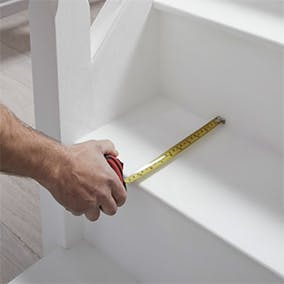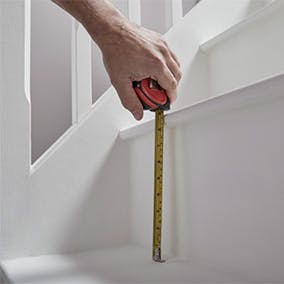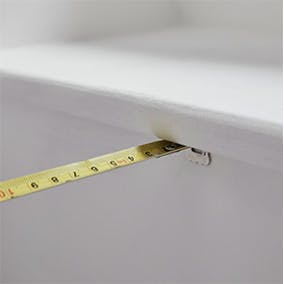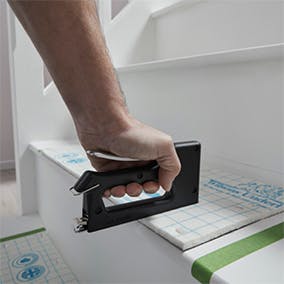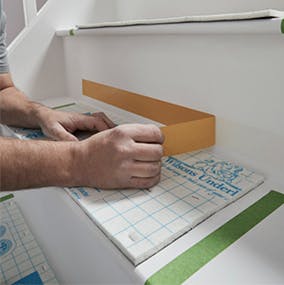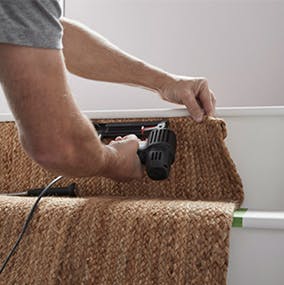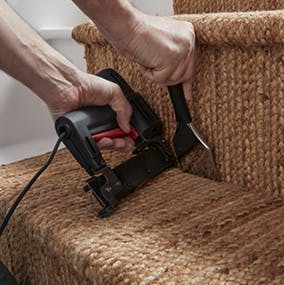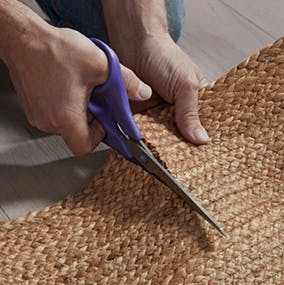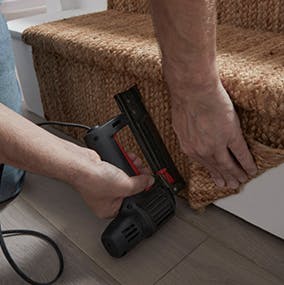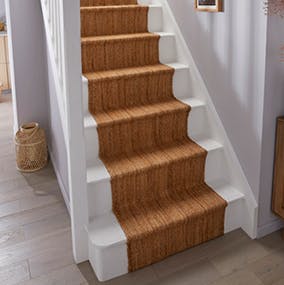How to fit a stair runner
Installing a stair runner is a great way to add an elegant aesthetic, not to mention a sense of drama, to a set of wooden stairs. Runners consist of a narrow strip of padding and carpet positioned in the centre of the stairs, leaving bare, painted or varnished wood on either side. If you’ve not had carpet on the stairs before, you’ll also notice that a stair runner will reduce the sound of footsteps and noise levels in general.
Stair runners are supported underneath by a thin, dense padding which prevents the runner wearing out and cushions footsteps. Standard carpet padding is too soft for this so make sure you opt for runner-specific products. Many people choose to add an extra statement to their stair runners with stair rods, or ornamental, metallic bars that ensure your carpet is securely in place.
Installing a stair runner is relatively simple and an experienced DIY-er should be able to do it. Alternatively, you can get a professional in. Whichever you decide to do, always make sure the runner is properly fitted to the stairs to prevent trip and slip hazards.
Tools you'll need before you start
- Stair runner.
- Carpet underlay.
- Staple gun.
- Bolster chisel.
- Sharp scissors.
- Carpet tape.
- Painters tape.
- Tape measure.
- A pencil.
In this guide
- How to measure for a stair runner.
- How to prepare stairs for a runner.
- How to attach a stair runner.
- How to cut off the runner excess.
- Frequently asked questions.
Step 1: Measure for a stair runner
Most stair runners come in a specified width (usually 57cm or 60cm) so you don’t need to worry too much about this. What is important is the length of runner you need.
To find this, measure the depth of the stair treads (the horizontal part of the stairs that someone would usually step on), the height of the riser (the vertical part of a stair) and the depth of the nose if there is one (the part of the stair that protrudes out). If your stairs don’t protrude out, you don’t need to worry about this as it will be covered in the tread measurement already.
Multiple these measurements by the number of stairs you have and add an extra 30cm as a precaution. This number is the length of stair runner you need.
Step 2: Prepare your stairs for a runner
Before you lay your stair runner, use this opportunity to give your stairs a lick of paint and a good clean. If they’re in need of repair, finish and tidy them up now.
If you know the width of your runner, deduct this from the width of your stairs and divide it in two to give you the gap on either side that your runner will leave. Mark this, along with the centre of your stairs with painters’ tape.
If your stair runner doesn’t come with padding, staple this to the stairs using a staple gun. Be sure to only pad the tread and the nose as no one steps on the riser. You also need to make sure your padding is 20mm narrower than the stair runner – otherwise it will poke out of the sides when the runner is placed on the top.
Add carpet adhesive tape to the riser.
Step 3: Attach the stair runner
Start from the top of the stairs, where you plan the runner to end. For most people, this will be the nose of the top step.
Staple the end of your runner to the stairs, starting in the middle and working your way out to either edge.
Ensure your carpet is pushed into the nook of the stair corner, where the riser meets the tread, with a chisel or carpet tucker. This makes for a neat finish. Add staples here to keep the carpet in place.
Repeat this process for every step.
If your stairs have a nose, you can choose between letting the stair runner skim past it onto the tread below or emphasising it by stapling around the nose. Be sure to decide on this when you’re measuring up and add extra length for the latter.
Step 4: Cut off the excess on a stair runner
Leave around 5cm (2 inches) of excess runner, then simply tuck the unfinished edge underneath and staple this into place just above the trim.
Finally, tack the edges of the stair runner with headless nails to make sure the sides are secure too.
Frequently asked questions
Why add a stair runner?
It adds a stylish element.
It takes the pressure off your feet by adding a layer of comfort.
The cushioned layer is ideal for reducing noise on hard floors.
It adds a layer of grip underfoot.
Do I need padding under my stair runner?
Yes, to add extra cushioning and to prevent your rug from slipping, potentially creating a trip hazard. Some stair runners have an in-built slip-resistant backing. We stock anti-slip which you can simply cut to size.
For additional padding, a carpet underlay can be used.
How easy is my stair runner to fit?
A stair runner can be fitted by an experienced DIY-er. You just need to know how to measure and use the tools to attach the runner to your staircase.
It’s important to fit a stair runner correctly to avoid it becoming a dangerous slip or trip hazard so, if you’re unsure, a professional carpet fitter will be able to assist.
How long does it need to be?
Your new stair runner should be the entire length of the staircase including the riser, tread length and, if there is one, stair nose. If you’re unsure, size up, using the instructions above.
What if I can’t find a stair runner in the length that I need?
If you can’t find the right length then you can always double up. Once you know the length required, find a stair runner you love and buy enough to make up the difference. When installing, join two stair runners together by folding the unfinished edges underneath and stapling along the fold.
Remember if you’ve chosen a runner with a design, order extra to account for any wastage when making the patterns align.
How do I care for my stair runner?
If fitted properly, a good quality stair runner should last a long time but there are some simple tips and tricks to keep it looking good. Just like carpet, a stair runner needs to be vacuumed regularly to prevent dust and dirt building up. As you’re also vacuuming painted or varnished wood on either side of the runner, choose a vacuum attachment that works on both carpet and hard surfaces to prevent chipping or damage.
Treat spillages the same way you would with a regular carpet. Dampen a cloth with tepid water and blot the mark or spill lightly as soon as possible. For more help with marks, stains and spills on carpets and rugs, see our guide.
It’s inevitable that, with heavy use, stair runners become loose over time. You can re-fit the runner using the same steps you used to originally install it. Simply, use a flat-headed screwdriver or similar to ease out the staples, re-apply the carpet tape and re-staple the runner securely in place.
